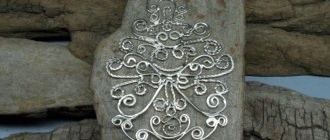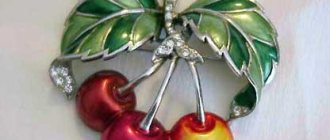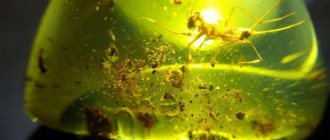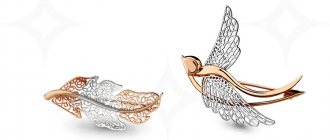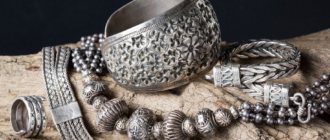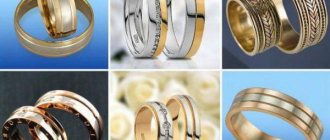Filigree (in Russian - scan , English filigree) is an openwork or wire pattern soldered to metal. And at the same time - a spoon and a glass holder in the buffet of many respectable families. The word “filigree” shows the essence of production: the Latin filum - “thread” and granum - “grain”, and the Russian “filigree” - from the Old Russian “skat” (to twist, twist). Most often, filigree is made of silver, but filigree patterns are also made of gold and other metals. Silver and gold are very soft and can be easily pulled out into very thin wires. The wire for the filigree pattern (silver, less often gold) can be smooth or twisted into ropes and spirals. Filigree was known throughout the ancient world (Crete, Egypt, Troy, Greece VI-IV centuries BC). This is one of the basic, “original” jewelry techniques.
Types of jewelry filigree
Filigree can be soldered, openwork and voluminous. In brazed filigree, wires and grains are soldered directly onto sheet metal. If the background is left, it is background or “blank” filigree. When, after soldering, the background is removed (by notching or sawing), then this is notched or sawn filigree. In embossed relief filigree, the pattern is soldered onto the embossed relief. In openwork filigree there is no metal base: the wire pattern is soldered on itself, and the grain is attached directly to the metal lace. If the “lace” is flat, then it is flat openwork filigree. If the lace is soldered in two dimensions and is voluminous (three-dimensional relief or high relief), then it is sculptural-relief openwork filigree.
“Russian filigree” in foreign sources . Volumetric filigree - cups, vases, trays, caskets and buildings, and even creatures - birds, animals. It is created in parts and then assembled into a single composition. In jewelry they use both flat (frame pendants), and openwork-volume (hemispherical complex brooches and rings, link and “solid” bracelets), and sculptural (animals, birds, bells) openwork filigree made of silver and other metals.
Kazakovskaya filigree. Slavic art
One of the oldest types of artistic metal processing is filigree (from Old Russian - to twist), or, as this type of jewelry technique is also called - filigree (from the Italian filigrana, in turn this word comes from the Latin words filum (thread) and granum (grain) , since the pattern is sometimes made not only from twisted wire, but from tiny metal balls).
Filigree can be called the apotheosis of ancient jewelry art, which has survived and exists in our time, being a kind of Russian symbol. Filigree is the making of jewelry using a special method. For this purpose, a method of twisting the thinnest wire made of precious metals (gold or silver) is used. The whole work comes down to manipulating gold thread: by twisting two wires, an openwork pattern of extraordinary beauty is obtained, which is then applied to the surface of the jewelry and soldered to it. This is quite painstaking and time-consuming work, since the jewelry maker has to process the entire surface of the jewelry in this way. The partial filigree method is also used when it is necessary to mask the joints of pieces of jewelry soldered to each other. Earrings, rings, and pendants are also processed with filigree, which make a great gift for a woman or man. Silver filigree is mostly common - silver jewelry is especially impressive and beautiful. Together with the filigree technique, filigree or granulation techniques are also used. These two methods are inseparable from each other - together they create an amazing impression of harmony. Filigree are miniature balls or grains of precious metal, soldered to the surface of the jewelry and forming a unique pattern. This method is very often used by jewelers, since filigree or granulation is very expressive and gives the product aesthetic power.
In Rus', filigree has been known for a very long time. Filigree items are found in excavations of burial mounds from the 9th century . Products of Kievan Rus were made using the graining technique back in the 10th century. In these things, twisted wire was almost never used. But already from the 12th century. grain fades into the background and soldered background filigree is increasingly used. From the 13th century the number of types of filigree is increasing - openwork and relief filigree are used. Stones are beginning to play an increasingly important role, and multifaceted solutions are emerging. Filigree items were produced in royal or monastic workshops. Master scanners conceived the products and carried out all operations for their production. In the 17th century The need for scanned items is increasing. A division of labor appears, artisans become independent, individual craftsmen produce wire and scanned elements. In the 18th century Large filigree items were made; along with stones, crystal and mother-of-pearl were widely used. At the same time, small silver items became widespread: vases, salt shakers, and boxes. Since the 19th century filigree products were already produced by factories in large quantities. They are diverse both in purpose and in assortment; expensive dishes, church utensils, toilet accessories. Technological techniques reach high perfection. Relief openwork filigree blossoms, translucent (window) enamel appears. In Russia, the village of Kazakovo in the Vachsky district of the Nizhny Novgorod region is becoming one of the largest centers of scanned production. The first Kazakovsky artel for the production of filigree items was formed in 1939. And during the Great Patriotic War, the artel did not stop its work: they wove officer shoulder straps, made stars for them, and made cigarette cases. In the post-war period, they mastered knife and fork production.
Information In 1927, a metal industry was founded in Kazakovo.
In 1939, twelve artel workers of the Kazakovskaya metal artel under the leadership of O.I. Tarakanova assembled their first filigree glass holder. The successor to the traditions and skills of the Kazakovsky artel was the Kazakovsky Art Products Enterprise CJSC (KPHI). The company inherits and develops the richest traditions of the past, seeks and develops new types of products. When composing a pattern, artists monitor not only the proportionality of its individual parts, the smoothness and beauty of the curves of large and small elements, but also the pattern of the gaps, since it plays a big role in constructing the pattern. Being in constant creative search, artists find new motifs and combinations. This is how they came to the use of gilding, the inclusion of natural stones, crystal, bone, and enamel in the design. The Kazakovsky plant produces a wide variety of artistic products: decorative vases and bowls, music boxes, glass holders, vases, candy bowls, women's jewelry, teaspoons, cups, medals, badges, orders and insignia for the Russian army. In recent years, the company began to produce church items - table and hanging lamps, icon frames, crosses, panagias. CJSC "KPHI" cooperates with the Holy Trinity, Seraphim-Diveevsky and St. Danilovsky monasteries, the Trinity-Sergius Lavra, Alexander Nevsky Cathedral, and churches of St. Petersburg. In addition, the company produces filigree products with heraldry and symbols of both government agencies and private companies. Since 1998, the company received the right to work with the mark of the Patriarchal Workshops with the blessing of the Patriarch of All Rus'. The products of the masters are exhibited at all-Russian exhibitions and have been awarded many awards.
Features of filigree In the mid-1950s, characteristic features characteristic only of Cossack filigree developed. A special feature of Cossack products is the independent significance of filigree: it is not used as part of the decoration of a metal object, as an overlay on metal, but entirely openwork products are created from filigree. Decorative panels and plates, vases and candy bowls, glass holders, boxes, various souvenirs, badges and medals - all these products are made entirely by hand. The filigree pattern is made from smooth or twisted copper wire according to a preliminary drawing on paper, to which individual details of the filigree ornament are glued. Then the future product is sprinkled with silver solder and soldered. When soldering, the paper burns, and the openwork curls are soldered together, forming a durable patterned lace. Further processing is silver plating with anode silver 999.9. An oxide film is applied to give the color of antique silver. Elements of a filigree pattern can be very diverse: in the form of a rope, lace, weaving, herringbone, path, satin stitch, etc.
Filigree is often combined with grains, which are small metal balls that are soldered into pre-prepared cells (recesses). The grain creates a spectacular texture and play of light and shade, thanks to which the products acquire a particularly elegant, sophisticated look. The materials for filigree products are alloys of gold, silver and platinum, as well as copper, brass, cupronickel, and nickel silver. Filigree is often combined with enamel (including enamel), engraving, and embossing. The filigree technique can be used to make all types of jewelry without exception. Fishing technology
Materials, tools Filigree continues to be a manual production - this is its characteristic feature. The technological process of filigree manufacturing is divided into preparatory operations: preparation of templates, filigree, its setting, soldering, mounting, surface finishing, each of which is performed by a master of a certain qualification. Preparatory operations The development of templates consists of dividing the product design into parts, each of which is unfolded on a plane. The elements that make up the drawing are clarified and classified. The types of filigree are established: twisted, smooth, thick or thin, flattened or round. If the pattern is too complex, it is divided into simple elements. Working with individual short sections and simple, albeit many, curls is much easier than with one, but several times bent wire. With high-quality soldering, the joints of the scanners are almost invisible. Filigree is made from pure metals - gold, silver, copper, which have good toughness, softness, and ductility. These qualities ensure wire drawing and rolling, its twisting and filigree set. Their melting point is quite high, which is convenient for soldering. As an exception, you can use alloys (for example, 916 silver) for large structural parts of filigree and for the production of grain. To select the wire for filigree of the required cross-section, it is passed through a selected die (ceisan) - a hole in the drawing board - a plate made of hard grade steel. Pulling is carried out without heating the wire, but during the process it becomes hard and therefore needs to be periodically annealed to restore softness. A drawing board with a series of successively smaller holes is strengthened in a vice, the end of the wire is sharpened with a file, threaded through the hole, and the entire wire is pulled smoothly using pliers. To reduce friction, the holes of the drawing board or the wire are lubricated with some kind of oil. By stretching the wire through a series of successively smaller holes, you can obtain the desired cross-section. Roll the wire into a skein, anneal it, bleach it in a weak (5%) solution of sulfuric acid and rinse well in running water.
Making filigree and grain You can roll (knit) filigree on the spindle of an electric motor, drill, or by hanging a rotating weight at the end of the wire. Twisting is done in two steps, between which the wire is annealed, restoring its softness. The rolled filigree is passed through flat rollers, flattened and annealed. The rolling can be strong, it can be almost invisible - it depends on the artist’s intention. The twisted filigree can also be left in the form of a cord, completely unflattened, and can consist of 3-4 wires. The cord can be made from wires of different thicknesses or from several already twisted wires, going in opposite directions. The filigree, woven like a braid from several wires by hand, gives the design great originality. Another type of filigree is a thin wire wound tightly onto a thick one, like a guitar string. A thin smooth wire can also be passed into a groove formed by two thick twisted wires. Items made using the filigree technique almost always include graining, which is a special accent in filigree lace. To ensure that the grains are the same, you need pieces of wire of equal size. To do this, a thin wire is wound in tight turns around an iron rod, removed from it and cut into separate rings. The rings can be laid out on charcoal or asbestos and melted. To obtain a flat base of the balls, mica should be placed. A set of filigree is divided into two operations: bending the details of the design and installing, fitting, gluing them in place. It’s more rational to prepare all the elements of the drawing and only then fix them in place. The elements are bent using tweezers - a forceps. The ends of these tweezers are pointed and allow you to capture the thinnest scans. The bending is done with the right hand, while the index finger of the left holds the end of the wire. The entire operation takes place on a flat zinc or aluminum plate.
Typesetting methods There are several ways of typing scans. Soldered filigree is used for flat products. The base is a thin sheet of silver or copper. The drawing is typed starting from the main structural details of the composition. These can be the contours of the design, the central rosette and its divisions, the places where the stones are attached. The pattern is filled with filigree details made from thinner wire and then the thinnest elements of the design, its filling. The last stage is grain placement. The filigree is glued with wood glue, cherry glue, BF-2 or nitro varnish. During the set process, it is necessary to ensure that all elements of the set fit tightly to each other along the entire length of their base. This will save you from repeated soldering, burning of parts, roughly soldered areas, and reworking of the rock surface. To accurately ensure the location of the grain, you should plant it in a ring, a curl of a skaninka or a special nest - a hole made by a canfarnik. This increases the soldering area and the strength of grain attachment. In cases where rings are not used, hemispherical grains made on mica are used. If the grains are located one after another, like a string of pearls, they can be collected between two thin wires running parallel.
Volumetric products A set of filigree for volumetric (with a background) products is made on pre-chased, extruded or stamped forms. This type of set is more complex than the previous one, because the scanner, in addition to its design, also bends according to the intended shape. If the shape is simpler, for example a cylinder or a cone, then the filigree can be typed and soldered on a plane, in a development, and then bent. On a more complex form, this will lead to deformation of the design, so the set should be done immediately on the required form. In this case, you also need to ensure that the entire surface of the scanner fits tightly to the form. Flat openwork filigree using wood glue, BF-2 or nitro varnish is typed onto thin smooth paper like sheet metal. The fit and strength of the set in this case is especially important, since the background will no longer support it. If the set is not tight, individual parts will fall out, which will complicate the soldering process. Volumetric openwork filigree is typed onto embossed or pressed templates - forms made of ordinary roofing iron. Everything here is produced with the same consistency as in openwork brazed filigree. The difference is that filigree can be easily removed from low-carbon iron. But at the same time, there should be no soldered seams on the iron that could separate when heated. Openwork volumetric products can also be made using the beating method. If the assembled filigree is well soldered, it can be easily knocked out and can be given any shape. The volumetric form is made from several or even two parts, which are then soldered together. It must be taken into account, however, that some parts are pulled out when punched out and distortion occurs. To avoid this, you need to give the necessary allowances when developing the drawing. When soldering, a frame is soldered to large volumetric filigree items on the inside for strength, or parts of the product are soldered separately and then mounted and soldered to the frame.
Soldering filigree When soldering, filigree assembled with wood glue must be tied with thin soft iron wire - bindra. This is done because when burned, wood glue swells and moves filigree parts that are not fastened together. If the filigree is set on nitro varnish or BF-2 glue, it is not necessary to tie it, since these substances burn out before the scanners have time to move. However, bulky items should be tied with a binder so that each scan is pressed. Openwork filigree typed on paper must be placed on a soft iron plate, previously rubbed with chalk (so that the filigree does not become soldered to it). For soldering copper products, solder is prepared from one part copper and two parts 875 silver. A silver product is soldered with solder from one part pure copper and four parts 875-grade silver. It is most convenient to use solder in the form of sawdust. To do this, clamp the ingot in a vice and file it down. Iron pieces that get into the solder (from a file or saw) should be removed with a magnet, otherwise they will oxidize and subsequently spoil the surface of the product when bleached. The flux used for soldering is borax. Pre-burnt (so that it does not swell during soldering) and crushed borax is mixed with solder (1:1). The soldering areas are moistened with a weak borax solution and sprinkled with the prepared mixture, which prevents the appearance of unsoldered areas and the filling of small filigree parts with solder. Soldering is done with a low flame. Kerosene, gasoline and gas can be used as fuel. For soldering with kerosene, a special lamp and heater are used, and for soldering with gasoline, a soldering apparatus is used; with gas, a special burner and heater are used. The flame should not be sharp and narrow (so as not to burn the product). For soldering filigree, you cannot use jewelry solders containing zinc, since during repeated soldering it burns out the shells and dissolves thin scans. However, if for any reason part of the pattern is damaged, it can be cut out, a new one made and soldered again. After soldering is completed, the item is thoroughly bleached in a 5% sulfuric acid solution so that the remains of glassy borax cannot interfere with subsequent finishing. The listed types of techniques for making filigree products are in turn divided into varieties, each of which has its own name. Soldered filigree can be: background - when a filigree pattern is soldered onto sheet material. In this case, the background may be shot, i.e. enrich yourself in texture; perforated or sawn - when after soldering, sections of the background are cut down or sawed out; relief - a filigree pattern is soldered onto a chased or stamped relief.
Openwork filigree also has varieties: flat openwork filigree - when the product has the appearance of lace, consisting of wire elements welded together; sculptural-relief openwork filigree - a three-dimensional relief or high relief formed by openwork filigree; multilayer filigree - when the pattern consists of several layers of filigree and the bottom one is like a background. This solution is approaching a sculptural one. The 3D filigree technique is often used to make dishes and toiletries. These are dishes, boxes, vases, caskets. Several types of filigree can be used in the product. Openwork is combined with precious stones, enamel, niello, with background filigree in chased relief and other techniques. The old traditions of filigree art are reflected in modern schools. Thus, the filigree of Armenia is characterized by thinness and flatness, that of Dagestan is characterized by an abundance of grains and hemispheres, and that of Kostroma is characterized by complex three-dimensional shapes. The ancient art of hand-made filigree is widely practiced in our modern times.
Source: © Slavic culture, https://www.museum.unn.ru,
Who owns the filigree technique?
It would be a mistake to consider that filigree is a purely Russian craft. The traditions of filigree art are alive in modern schools in different countries. The filigree of Armenia is subtlety and flatness, of Dagestan - an abundance of grains and hemispheres, of Kostroma - complex volumetric shapes. Products using the filigree technique are produced by jewelers from various countries - France, Italy... Painfully familiar silver openwork patterns can unexpectedly be found in jewelry, for example, from Ecuador. And you shouldn’t be surprised by this, because it is in Latin America that ancient “silver” crafts, including filigree, are especially alive.
Examples of Ecuadorian filigree jewelry:
How is filigree jewelry made?
Elements of a filigree pattern are rope, cord, weaving, herringbone, track, satin stitch, and so on. It is essentially a lace appliqué made from metallic thread. Filigree is often combined with granulation - small balls that are soldered into prepared cells (recesses). The grain gives filigree a particularly elegant, sophisticated look. The materials for the products are alloys of gold, silver and platinum, as well as copper, brass, cupronickel, and nickel silver. The filigree technique can be used to make all types of jewelry without exception.
Silver filigree and more - manufacturing technology
A master scanner (who worked in royal or monastic workshops) worked along the entire “chain” of the process, from conception to completion of the product.
In modern jewelry production, of course, division of labor has long been used, but the technology for creating filigree jewelry itself has changed little. What does filigree production technology look like? In general, to “type a filigree”, you first need to bend the details of the design, and then install, adjust, and glue them in place. It is more convenient to prepare all the elements of the design, and only then secure them in place. Elements of the filigree pattern are bent using tweezers - forceps. Its ends are pointed and capture the thinnest “scans”. The curved parts of the future scan are laid out on paper with a pattern already applied and the set is carried out in the same way as on sheet metal (in the case of a background scan). The density of the set is “extremely important” - the “curls” are soldered only to each other, the background is “no help” for them. If the set is loose, the openwork filigree “crumbles,” which means secondary insertion and soldering. When soldering, the paper with the pattern applied burns, and the curls are soldered together, forming a durable patterned lace. The final stage of filigree manufacturing technology includes silver plating of the product with 999.9 anode silver. Aging is carried out by oxidation.
How was the filigree “tempered”? The history of the heyday of filigree
In the 17th century, the demand for filigree jewelry grew. In the 18th century, serious filigree items were created; along with stones, crystal and mother-of-pearl were used. Little joys are not forgotten either - vases, salt shakers, boxes. Since the nineteenth century, filigree has become a manufactured product. The technology is being honed, relief openwork filigree is blooming, and translucent stained glass is appearing - openwork filigree with transparent enamel. Having experienced decline at the beginning of the twentieth century, filigree jewelry techniques have regained strength since the middle of the century. In 1937, the works of craftsmen from the village of Krasnoe-on-Volga ( "Krasnoselsky Handicraftsman" , near Kostroma) were shown at the World Exhibition in Paris, where they took gold for filigree brooches, boxes and other accessories, and in 1939 - in New York . They also took up filigree in the village of Kazachkovo (Vachsky district of the Nizhny Novgorod region).
Kazakovskaya filigree – modern production
Today, the Kazakovsky Art Products Enterprise (KPHI) is a serious “filigree” brand (website kphi.rf), specializing specifically in products using this technique. KPHI brand jewelry is usually made of silver-plated alloy.
What distinguishes Kazakovskaya filigree? When composing a pattern, the master monitors the harmony of its individual parts, the beauty of the lines of large and small elements. The artist also works on the design of the gaps: this is extremely important in constructing the pattern. The charm of Cossack products lies in their openwork - filigree as an end in itself. The KPHI website has spread a filigree web of powerful temptation.
Lures are varied: filigree dishes - for reasonable housewives; for hipsters - filigree flash drives; to the ruling authorities - kits for the consumption of alcohol and tobacco. Women's jewelry is not forgotten either - it is spectacular and elegant at the same time. “Slavyanka” jewelry combines fidelity to style with originality and purity of finish. The lack of inserts softens the price.
Examples of products from Kazakovskaya filigree (KPHI):
Filigree from "Kubachi"
Kubachi jewelers (kubachi.su), along with the traditionally famous Dagestan technique of blackening, chasing and engraving, also produce filigree items of incredible beauty.
Examples of filigree work by Kubachi jewelers:
Filigree. Features and meaning of filigree technique
Features of filigree
Filigree is not complete without thin wire. It is twisted into openwork patterns or soldered onto a metal base. The name of the technique is taken from the Greek language.
In it, the word “filigree” means “twist”, “knot”. In Rus', this meaning was put into the verb “skat”. Therefore, in the domestic space, filigree is still called “filigree”.
The meaning of the filigree technique is to create a structure out of metal that resembles lace. It is not possible to imitate airy fabric using thick wire. The base for filigree, most often, does not exceed 1.5 millimeters in diameter.
Jewelry techniques are divided depending on the shape of the metal thread. Round wire is not always used. Sometimes it is deformed and flattened into a ribbon.
Filigree designs are laid out either with a single thread or with cords formed from several wires. Metal spheres often add volume to compositions.
They are attached using solder to the outside of the products. The first example of such work is jewelry found by archaeologists in Egypt. The items date back to the second millennium BC.
Metal balls soldered onto twisted wire are called grains. Hence the name for filigree using spheres – granulation. This technique prevailed until the early Middle Ages.
From the 13th century, goldsmiths began to emphasize filigree made only from wire. Silver and gold threads are considered classic options. Other metals are rarely used.
The Filigree technique is not subject to machines. It is done only manually. Even copper products are expensive. Customers of exclusive items are willing to pay extra for precious raw materials.
The raw materials for filigree are 100% precious Only pure metals are used, without impurities. Additives make gold and silver less ductile, which is unacceptable for filigree.
To recreate the smallest “knitting”, the most pliable wire is needed. In ready-made samples, this quality of the material ceases to be a plus.
Filigree is easy to damage and make a dent on the product. In this regard, craftsmen often place a base - metal sheets - under the openwork surface. They make jewelers' creations durable.
Classic filigree is a team effort. Several craftsmen work on the products. A dedicated specialist is assigned to each stage of the work: preparing the template, twisting the metal thread, folding it into patterns, soldering them, mounting and decorating the surface of the object.
The sketch should show the product on a plane. The pattern is divided into parts depending on the filigree technique used in different elements of the composition.
Often, parts from different types of wire are combined in one item. For example, both thin and thick threads are used in boxes; flat and round wires; twisted and smooth blanks.
Thread twisting is partly automated. The wire is twisted using an electric motor, or more precisely, its spindle. Some craftsmen also use drills.
Rollers are also used to form blanks. In them the wire is flattened. Twisting threads into cords and laying them out according to the intended pattern is only possible by hand. This also applies to decorating products.
There are exceptions when the filigree is not made of wire. Thus, in the 15th and 16th centuries, craftsmen mastered the technique of openwork processing of wood and ivory. Many cavities were cut out in them.
The voids gave the products airiness and the texture of lace. Some modern craftsmen also make filigree ivory samples. The bone in their products is not real. Elephant hunting is prohibited. Designers use adhesive mass. As it hardens, it skillfully imitates natural material.
Paper filigree
The non-jewelry industry also includes paper filigree. This type of technique is called quilling. To “knit” patterns, designers use sheets of metal.
They are cut into strips 3-6 millimeters wide and 40-60 centimeters long. The blanks are twisted in a spiral. They are deformed, giving the workpieces different shapes. The resulting ovals, circles, squares, etc., are laid out by craftsmen in compositions.
Jute filigree
Metal is also replaced with vegetable cord. The technique is called " jute filigree ". The name comes from the name of the plant from which the threads are obtained.
Jute belongs to the linden family. The fibers of the bush are coarse and grayish-brown. They are not soldered, but, like paper samples, glued together. Jute threads are used to make two main elements – loops and curls. All patterns developed by artists consist of them.
Jute, paper, metal... any filigree can be flat or voluminous. The “knitting” technique is used to make vases, caskets, and dishes. Flat filigree is useful in paintings, jewelry, and interior decorative elements.
By the type of products, you can often determine where they come from. In Dagestan they specialize in products made from hemispheres, richly decorated with grains.
In Armenia, on the contrary, they teach how to create planar filigree from thin threads, without adding spheres. In Russia, Kostroma is considered the center of filigree. Samples of complex shapes are made there. All creations of Kostroma masters are three-dimensional, consisting of elements of different shapes and sizes.
The painstaking work of creating filigree has been compared to the task of shoeing a flea. It’s not for nothing that there is a characteristic “filigree work”. This is what they say about works that stand out from the general background, performed skillfully.
So, filigree is not complete without thin wire. Its existence is impossible without the talent of the master.
Where can you buy real filigree jewelry?
Unfortunately, finding true filigree is not so easy. Not all jewelry enterprises (and KPHI is a typical example) disclose on their websites the names of retail chains with which they cooperate to sell products. As a result, you can completely accidentally “come across” scanned items by simply going to a regular jewelry store near your home - with the same success as not finding it at all, having walked around a dozen stores.
One of the more reliable ways today is to attend jewelry exhibitions, which are regularly held in Moscow and other large cities (jewelry exhibition calendars). More or less serious jewelry companies from different parts of the country are represented there, making jewelry using a wide variety of techniques. And you can even meet those manufacturers who do not sell through stores at all, whose assortment can be seen exclusively at exhibitions.
If you wish, you can also try searching for filigree products made in different countries (including eastern ones - Nepal, Thailand) in online stores, as well as on the websites of private jewelers, websites for collectors, or foreign stores or hand-made resources like etsy.com. On the latter you can find beautiful antique specimens.
As we find manufacturers and retailers offering real filigree, we will add them to our Manufacturer Directory and Seller Directory, where you can find them by specifying your search parameters.
Products with “filigree elements” versus “true filigree”
Jewelry almost always contains filigree elements: a scattering of beads of grain, a cord or rope of metal around an insert with a stone or pearl. Sometimes filigree curls and grains are soldered onto cast or stamped parts of the jewelry. On the one hand, this is no longer completely filigree and not purely handmade. But such “combi-filigree” is often stronger, cheaper and more accessible than its noble “cousin” - pure hand-made filigree.
The balance of aesthetics and practicality will give the buyer the desired vector. Let's say the strength of the earlobe is not limitless. And your goal is voluminous earrings or a pendant. In openwork hand-made filigree, the ratio of dimensions to weight is the most humane, perhaps this is “to your advantage” (to your ears). Bracelets and rings may require greater strength, and then “mixed” filigree will seem “stronger” than filigree. The main thing, as always, is to understand the difference between true filigree and its imitation, consciously giving money for this or that product.
For comparison: on the left is a ring with “filigree elements”, on the right is a filigree bracelet
LiveInternetLiveInternet
square dance master
source https://www.supersadovnik.ru
I have never hidden my interest in filigree and have long been looking for an opportunity to do something in its spirit. I was not satisfied with the replacement materials. The most pliable of them are threads and they become shaggy ((. Quilling is not practical! But at some point the sclerosis was released and it began to twist! . First, a few words about the filigree itself. The process of making filigree is very interesting, but labor-intensive. First of all, the wire, clear The thing is, they don’t take old cables, but make them by hand. Then they twist it in several steps with intermediate annealing and bleaching in acids. The wire is annealed so that it becomes softer and more elastic. After all, the wire must be twisted so that the turns are perpendicular to the axis. For Twisting alone will not achieve this - it breaks. Then the twisted wire is passed through rollers to flatten it. The ratio of thickness and width is at least 1:3. The number of devices for winding patterns is frighteningly large, the names are brain removal. Each connection is filed so that it does not scratch. But this is not the most important thing! The product of a real master is distinguished by the absence of traces of soldering! I will not list what is needed in order to solder it well. This is already the highest matter))). How to apply this for our needs. Precious metals are swept away. What remains is available copper and industrial silver. The melting point of copper is just over 1000 degrees. Having a gas burner, annealing can be done; you don’t want to mess with acid, but it’s also possible. That is, it is possible to obtain the wire of the desired twist with a certain amount of training. You can squeeze your husband and get rollers. You can twist patterns without buying jewelry tools, the result will be worse, but it will be there. For me, soldering is very problematic. But if we have done all this, what do we get as a result? That's right - a piece of jewelry))). And a legitimate question arises - why stick it on the bottle then? Therefore - “filigree-light”)))). Now about sclerosis! Ladies my age remember how in the 80s chains consisting of links of twisted wire were in fashion. Beaten, polished or simply round. This was done very simply, one might say on the knee. One twisting device is enough. This is the device my sister’s husband brought me. And even a coil of wire with technical silver. I didn’t make chains, but I had earrings to go with all my outfits, beads, beads and twisted wire. The fashion has passed, but the adaptation remains. And in a moment of enlightenment, I remembered her!! The size of the "beast" is small. just right for chains - 8 centimeters. It’s quite suitable for small elements, but it’s difficult to make a long outline of a picture from parts! I couldn’t think of anything to twist long wires. Until my husband got into the moment. As a result, I have two such devices. Real filigree is turned using a vice and some kind of mechanical rotating contraption. This is necessary so that there is some play in the wire. As it twists, it shortens. By loosening it a little, you can give it the opportunity to spin some more. That’s why my second device has a removable handle. The wire itself pulls it up. So we take the wire, clean it, unwind it, cut it into pieces a little larger than the device, twist the ends. We put them on the pins in pairs. Let's spin. Result: - untwisted wire from wire In filigree, wires of different thicknesses and patterns are used, smooth rolled (or simply round) wire, the so-called satin surface, is also used, cords from several wires are twisted. But, as far as I understand, the height of the picture should be the same. Without rolling, it is problematic to use wire of different thicknesses, and this part is still in the process of being thought about. For gluing, I used everything that was adhesive in the house: “Titan” glue, “contact”, acrylic varnish. She refused the gun - very thick drops. About glues (glue??). Contact is a dangerous thing))). Glues his fingers tightly))). Very convenient for gluing large, long elements. The droplets are small, you can run a thin strip along the wire. It sets very quickly. Good for use on difficult surfaces. The downside is that it can be grasped together with the tool or your fingers. In its liquid state it reacts with varnish, leaving white spots. But after varnishing, the stains disappear. (I'm talking about "Ballet"). You can glue the wire in parts. For example, fix the edges and then grease the middle. “Titanium” is difficult to smear, because the glue is viscous, it goes on greasy, but if you pass the wire between your fingers, a very thin layer remains. It is sufficient for gluing wire to a slightly curved surface. Excess can be easily removed from the surface. But it’s better not to remove it immediately, but to let it dry a little. Then you can easily scrape it off with a toothpick!
I continue. How I do THIS. Using the “Night Bouquet” set as an example. But at this job, I did a terrible stupid thing. Spray paint. The “contact” ended, and the “Titan” connected the paint and the wire, but the adhesion of the paint to the glass turned out to be insufficient and where the wire did not fit tightly, the paint came off the bottle and began to bubble. Therefore, I later switched to varnish. Wire - not a napkin, not plastic, not a thread - will not voluntarily lie in the desired curve. We cut out a circle or an oval from paper, which is necessary to start working with the edging of the picture, and bend the wire with our fingers. She is soft but stubborn. We'll have to force her to lie down properly. Bent. Cut off the excess with pliers. Strange - it looked like a perfect circle. Since I switched to varnish, we fill it without regret. “Ballet” allows you to be rude))) But the varnish is too liquid, so the glued element cannot be corrected in the process, otherwise it will not stick. But on the bottle you can’t do without glue, the sides are too curved. This is where everything started to swell. I had to scrape and trim with acrylic. Once we've done the edging, it's time for the little things. Girls, I work without a sketch. Each element grows and heads, clinging to the previous one. So I bend the sampler – I like it – I straighten it, cut it to the required amount and bend it all. In this work the elements are simple, but in the emerald one they are complex. It turned out to be impossible for me to repeat an element if it was glued a while ago. So I do everything at once and glue it. Small parts are easier to glue onto varnish! The glue will smudge everything. Apply a brush to the gluing area and place the figurine with tweezers. Circles are easy to make. So that they are of equal diameter, we wrap them around a toothpick, a pencil, or any tube of the required diameter, remove them and bite them off one by one. By the way, I only found out later that grain is made this way. They cut the wire into rings and melt them. The balls form on their own. We cut circles, but they have turns and edges at different levels. Roll with something heavy. I have a weight for holding drawings!. And glue it onto the varnish. We do the loops the same way. We cut equal pieces and bend them through a round object. Semicircles - there are two options - or we cut circles from coils in half, or we bend equal sections through a tube. And like a puzzle, we put the picture together piece by piece. Everything whitish is not a defective photo, but a varnish! Once again - I have “Ballet”! I'm not advertising it, but clarifying it. It may not work with others. The mesh was made using graduated fum tape. I had to glue it onto the Titan; nothing else would have held it. First she put it on one side, then on the other. The edges of the mesh are not glued, then we cut it to size and outline it. The job turned out to be easier than the previous one. Therefore, I cannot demonstrate all the bending options. I will describe in words the most interesting ones. On the neck of the glasses there is a zigzag using a comb. A complex zigzag at the bottom of the neck of the bottle - round pliers and fingers. There are still a lot of double curls - with round nose pliers. In general, everything comes into play. Unfortunately, unlike real filigree, it is difficult to make complex elements from many wires. Because The wires are round - the joint will be very thick and ugly. Thank you for putting up with me for so long and I really hope that someone will bring something new!
How to wear filigree jewelry: our recommendations
Wearing filigree requires an approach: its “lace” requires a contrasting background, stylistic unity with clothing. Light filigree looks luxurious on dark skin, looks clear against the background of dark hair, and goes well with a dark manicure. Blackened filigree is especially effective on pale skin, or with pastel-colored clothing. In a word, any contrast - color, graphic or texture (we mean smooth fabrics: satin, satin, etc.) will “reveal” a filigree product. And if everything is taken into account, then know: wearing filigree, you will not get lost in the crowd.
JEWELRY MAKING | Jewelry techniques - types Jewelry with enamel | Hot and cold enamel technique | Cloisonné technique | Georgian cloisonne enamel | Rostov enamel
Metal chasing. Metal engraving technique. Embossing on metal Blackening of gold and silver. Northern blackening plant - blackening classics | Metal etching. Chemical gilding. Silvering of jewelry. Oxidation, and other coatings | Chainmail weaving and its types
Share this article with your friends
Works by designers from the JEWELIRUM catalog
- Co.Cos Jewelry
- Co.Cos Jewelry
- Taiga Jewelry, Tomsk
- Taiga Jewelry, Tomsk
- Ilya Maksimov, Crimea
- Ilya Maksimov, Crimea
- UBIRING
- UBIRING
- Diamonds are Forever
- Diamonds are Forever
- Rings in natural style, Sergacheva Jewelery
- Earrings with pearls, Sergacheva Jewelery
- Cabochon ring, Minty Sky
- Fly earrings, Minty Sky
- Ring, Precious Park
- Ring, Precious Park
- Snake skin ring, Stoyanova Jewelery
- Chain earrings, Stoyanova Jewelery
- Children's pendant - stick, Matthew&Daniel
- Pendant for a child, Matthew&Daniel
- Bracelet, Svetlana Subbotina
- Ring with Slavic symbols, Svetlana Subbotina
- Indian style ring, Anna Goffman
- Indian style ring, Anna Goffman
- Earrings, ISTA
- Geometric ring, ISTA
- Earrings with enamel, PNJewelry
- Ring with enamel, PNJewelry
- Ring, Khramtsova Jewelry
- Ring, Khramtsova Jewelry
- Wedding rings to order, obruchalki.com
- Wedding rings to order, obruchalki.com
- Earrings, Yuri Bylkov
- Earrings, Yuri Bylkov
- Titanium bracelets, LanaMuransky
- Titanium pendant, LanaMuransky
- Brooch Elephant (after Salvador Dali), THING
- Ring Veil, THING
- Mace earrings, VLADIMIR MARKIN
- Cufflinks, jewelry mechanics, VLADIMIR MARKIN
- Drop-shaped ring, EKATERINA TOLSTAYA
- Drop-shaped earrings, EKATERINA TOLSTAYA
- Necklace with amber, LETA
- Earrings with amber, LETA
- Children's earrings, combinable, FASHBY
- Children's earrings, combinable, FASHBY
- Ring of architectural form, Elizaveta Malafeevskaya MANU_L
- Architectural bracelet, Elizaveta Malafeevskaya MANU_L
- Set Ginkgo Leaf, SHABUT JEWELLERY
- Brooch Wearable porcelain, SHABUT JEWELLERY
- Architectural ring, GEOMETRY
- Brooch, porcelain, GEOMETRY
- Necklace made of polymer clay, LICORNE ART
- Brooch made of polymer clay, LICORNE ART
- Ring, avant-garde, VALERY SEREDIN
- Bracelet, avant-garde. VALERY SEREDIN
- Wooden set, Scandinavian/Japanese minimalism, VLADIMIR SHESTAKOV
- Ring, Scandinavian/Japanese minimalism, VLADIMIR SHESTAKOV
- Earrings, TON ANT
- Ring, TON ANT
- Architectural ring, ANCHOR
- Architectural necklace, ANCHOR
- Earrings, GOHFELD JEWELLERY
- Necklace, GOHFELD JEWELLERY
- Massive ring, YAKISCHIK
- Designer jewelry, YAKISCHIK
- Architectural ring, ONE DAY ART
- Architectural ring, ONE DAY ART
- Brooch, bionics, VALERIYA MARKOVA (TESSA)
- Unclosed ring, bionics, VALERIYA MARKOVA (TESSA)
- Ring, bionics, BEAVERS
- Earrings, bionics, BEAVERS
- Earrings, asymmetry, VAGANOVA JEWELRY
- Airplane ring, VAGANOVA JEWELRY
- Flower ring, ALCHEMIA JEWELLERY
- Set, ALCHEMIA JEWELLERY
- Pendant-cat, ethnic, STUDIO OF ILYA AND VERA PALKIN
- Earrings, STUDIO OF ILYA AND VERA PALKIN
Comments
- Natalia
help me find a jeweler who works in filigree technique. I want to order a bracelet in the style of ancient oriental filigree. Thank you
6 years ago Reply
- juvelirum
Natalya, good afternoon! Unfortunately, we personally don’t know any jewelers who specialize in filigree or filigree. Try asking a question on jewelry forums or go to the nearest jewelry exhibition, where there are usually many craftsmen (exhibition schedule:)
6 years ago Reply
- Emma
in the Altai Republic, Ongudai district from Kupchegen, there is a workshop there that makes a lot of beautiful handicrafts from leather, iron, wool, felt, including filigree.
6 years ago Reply
- Ilyas
I am a jeweler artist, write to me.
4 years ago Reply
I make jewelry using the filigani technique, I have experience, +79821025673
4 years ago Reply
